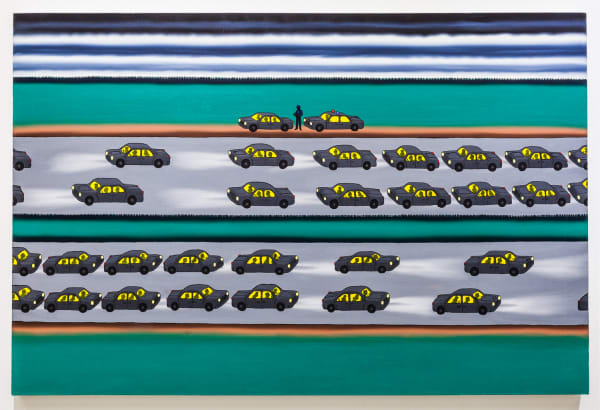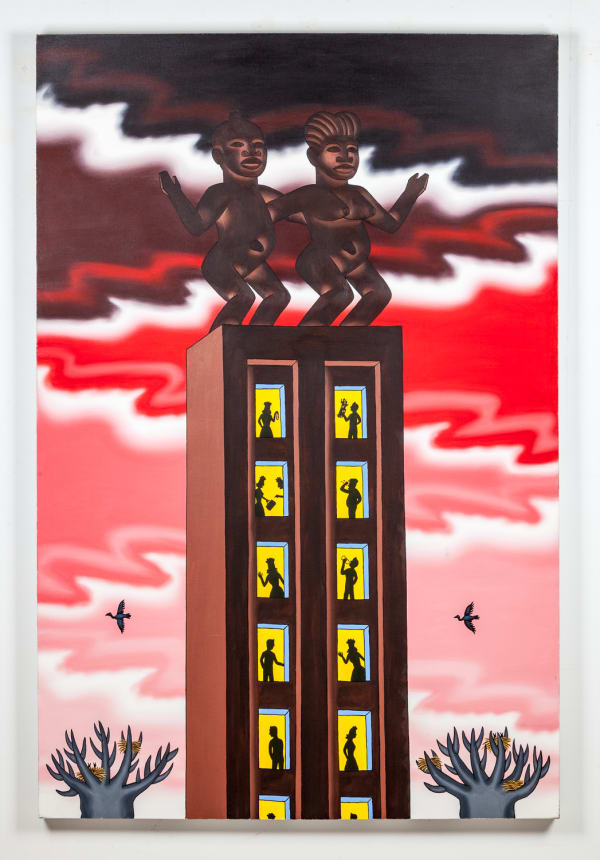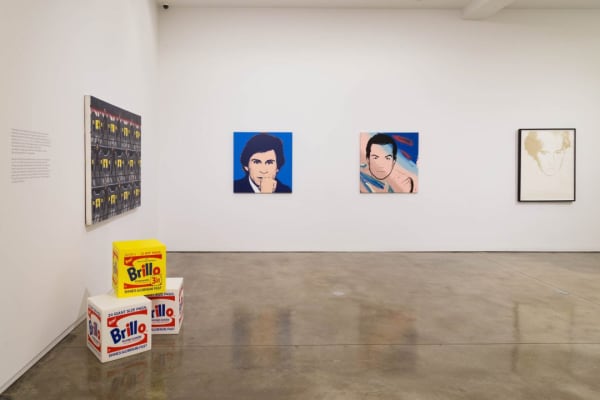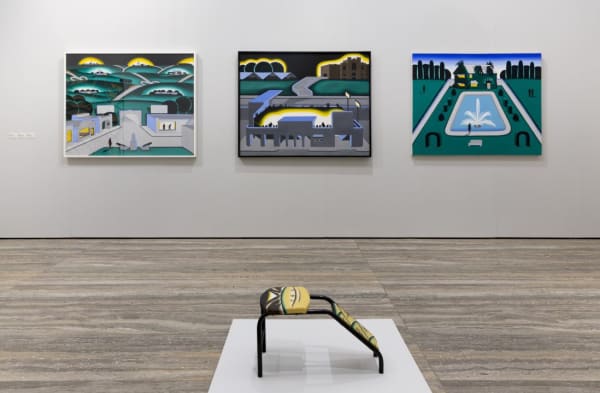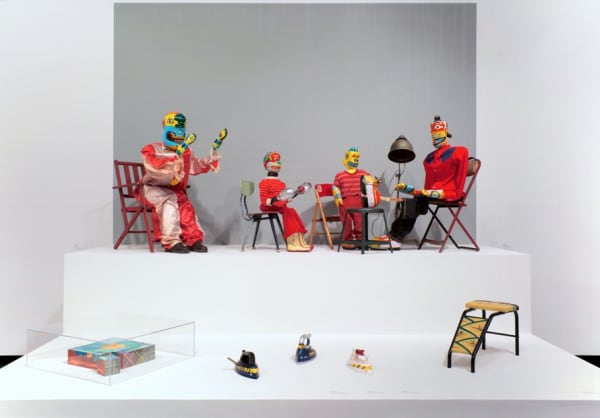-
-
Roger Brown: His Political Landscape, Art Basel OVR:20c
Kavi Gupta is delighted to announce our participation in OVR: 20c — the latest iteration of Art Basel’s Online Viewing Rooms, dedicated to works from the 20th century — with our presentation of Roger Brown: His Political Landscape.
Roger Brown (b. 1941, Hamilton, Alabama, USA; d. 1997, Atlanta, Georgia, USA) was a keen commentator on contemporary American life. Born in the Deep South and spending his adult life primarily in the Midwest, Brown was perennially marginalized by his status as an out gay man. He mobilized political figuration in painting with fearlessness and wit to communicate the political realities that comprised his lived experience of the world. This exhibition showcases a selection of works from the early 1970s through the 1990s, covering the majority of Brown's working career as an adult, and considers some of his means of articulating landscape painting as a genre fertile with possibility for cultural commentary. Diversely fascinated by such topics as American imperialism, the internal politics of the art world, environmentalism, terrorism, queer culture, and the AIDS crisis, Brown's expansive interests collectively paint a portrait of a rapidly changing world in the late 20th century.
Brown was a pioneering American artist whose extensive and diverse oeuvre both translated and transformed the visual and cultural landscapes of his time. Brown was a leader among the Chicago Imagists, yet his work transcended regionalist concerns and set him apart as a radical visionary amongst his contemporaries. Born and raised in the rural South, Brown moved to Chicago in the early 1960s. His interests ranged from the Italian Renaissance, to Surrealism, to Comics and Pop Art, and he was a connoisseur of autodidact art traditions of the American South and Midwest.
Scroll down to view more works below. Explore the fair through the link.
-
-

Roger Brown
Roger Brown (1941–1997, USA) is renowned for using a pop aesthetic to investigate a range of sociopolitical issues. His trademark silhouettes and curvilinear landscapes depict both the topical and uncomfortable. Brown’s work is of startling contemporary relevance, cleverly approaching many topics from the natural and built environment, disaster, religion, the art world, popular culture, art history, eroticism, and socio-political concerns from modern warfare to mortality during the HIV/AIDS crisis. Rich in content and innovative in methods of depiction, Brown presaged the subjective and surreal figuration seen in many threads of recent painting.
During his lifetime, art dealer Phyllis Kind was Brown’s exclusive representative, and she was the first to exhibit his work in 1971. Brown’s career abounded with solo and group shows internationally, and notable retrospectives of his work were shown by the Montgomery Museum of Fine Arts in 1980, and at the Hirshhorn Museum in 1987. A longtime resident of Chicago, Brown divided his time between Chicago and New Buffalo, MI, and in the 1980s he began wintering in La Conchita, CA. Brown received his BFA and his MFA at the School of the Art Institute of Chicago in the 1960s, partly under the tutelage of Ray Yoshida, as one of a generation who would later become known as the Hairy Who, or the Chicago Imagists.
The Roger Brown Study Collection, maintained by the School of the Art Institute of Chicago with curator Lisa Stone, makes Brown’s prolific art collection and archive available to the public. Brown’s political paintings were recently featured at DC Moore Gallery, New York and his Virtual Still Life works were highlighted in a solo exhibi-tion at Maccarone, New York. The artist’s work is included in notable private and public collections including The Metropolitan Museum of Art, The Museum of Modern Art, The Whitney Museum of American Art, The Art Institute of Chicago, Museum of Contemporary Art, Chicago, Los Angeles County Museum, Museum of Fine Arts, Boston, National Gallery of Art, and The National Portrait Gallery.
-
-
-

His Political Landscape
Roger Brown’s highly political practice articulated the landscape as a tool for cultural commentary. A snapshot of his life and times, Brown’s painted landscapes capture the political landscape of the late 20th century with uncompromising honesty.
Brown (b. 1941 Hamilton, Alabama, USA; d. 1997 Atlanta, Georgia, USA) was a keen commentator on contemporary American life. Born in Deep South and spending his adult life primarily in the Midwest, Brown was perennially marginalized by his status as an out gay man. He mobilized political figuration in painting with fearlessness and wit to communicate the political realities which comprise his lived experience of the world. This exhibition considers a selection of works from the early 1970s through the 1990s, covering the majority of Brown’s working career as an adult, and considers some of his means of articulating landscape painting as a genre fertile with possibility for cultural commentary. Diversely fascinated by such topics as American imperialism, the internal politics of the art world, environmentalism, terrorism, queer culture and the AIDS crisis, Brown’s expansive interests collectively paint a portrait of a rapidly changing world in the late 20th century.
Brown was a pioneering American artist whose extensive and diverse oeuvre both translated and transformed the visual and cultural landscapes of his time. Brown was a leader among the Chicago Imagists, yet his work transcended regionalist concerns, and set him apart as a radical visionary amongst his contemporaries. Born and raised in the rural South, Brown moved to Chicago in the early 1960s. His interests ranged from the Italian Renaissance, to Surrealism, to Comics and Pop Art, and he was a connoisseur of autodidact art traditions of the American South and Midwest.
-
-
-
-
-
-

As a queer man, Brown was intimately aware of the inherent biases suffered by any outsider who dared to challenge existing social, political, and cultural traditions. With immense wit and self-deprecating humor, Brown bravely faced his foes, creating a distinctive visual legacy along the way. Brown eventually died after a long battle with complications related to HIV/AIDS. His struggle with this disease played an important role in his work, as well as in his personal life and philanthropy. Brown’s life and work are honored with permanent exhibitions of his house and studio in the Lincoln Park neighborhood of Chicago, which include his vast collection of folk and vernacular art.
The depth and power of the body of work Brown left behind is only now beginning to be grasped. Brown’s ideas, and the grace with which he expressed them, will be studied for generations to come.
Brown’s work is included in the collections of the Art Institute of Chicago, the Whitney Museum of American Art, the Museum of Modern Art, New York, the Metropolitan Museum of Art, the Smithsonian American Art Museum, the Los Angeles County Museum of Art, the Scottish National Gallery of Modern Art, Edinburgh, Museum Moderner Kunst, Vienna, and several other important institutions. Several major retrospectives of his work have traveled the United States, including those at the Hirshhorn Museum and Montgomery Museum of Fine Art. Recent important group shows include Theater of Operations: The Gulf Wars 1991–2011 at MoMA PS1, About Face: Stonewall, Revolt and New Queer Art at Wrightwood 659, and Famous Artists from Chicago 1965-1975 at Fondazione Prada. Recent solo exhibitions include Roger Brown: Virtual Still Lifes at the Museum of Art and Design, New York, and Roger Brown: Hyperframe at Kavi Gupta.
-
-

Roger Brown, HYPERFRAME
Kavi Gupta | 835 W. Washington Blvd., Chicago, IL 26 March - 27 November 2020Kavi Gupta presents Roger Brown: Hyperframe, an exhibition bringing together an unprecedented selection of multi-frame paintings by one of America’s greatest Imagists. -

Roger Brown and Andy Warhol, Politics, Rhetoric, Pop
Kavi Gupta | Elzabeth St 23 September - 22 November 2016Penning a list of pop artists including Roy Lichtenstein, Andy Warhol, and himself, Roger Brown writes in the 1980 Who Chicago? that “what is shared is attitude and not style.” Brown’s admiration for—and aesthetic affiliation with—Warhol’s work positions him far beyond the superfluity of purely regionalist designations. Roger Brown & Andy Warhol -

Roger Brown Estate, Famous Artists From Chicago 1965-1975
Fondazione Prada | Milan, Italy 27 October 2017 - 15 January 2018Fondazione Prada will present at its Milan venue a research and information program on the Chicago art scene developed in the aftermath of World War II. -

Roger Brown: Virtual Still Lifes
Museum of Arts and Design | New York, NY 2 May - 15 September 2019Roger Brown: Virtual Still Lifes brings together, for the first time, a vast grouping of the artist’s “Virtual Still Life” paintings (1995–97) made near the end of his career. -

Roger Brown, La Conchita
Kavi Gupta | 219 N. Elizabeth St. Chicago, IL, 60607 10 November 2018 - 12 February 2019Kavi Gupta is pleased to present Roger Brown: La Conchita. Opening November, 10 at the Kavi Gupta Elizabeth St. location, the exhibition will feature the contents of Roger Brown’s southern California home. Brown, seeking a new place to work in a warmer climate, built his Temple of Painting at La Conchita, California, commissioning Stanley Tigerman to design the new home. -

Roger Brown, 3-D Doings: The Imagist Object in Chicago Art, 1964-1980
Tang Art Museum | Saratoga Springs, NY 8 September 2018 - 6 January 20193-D Doings: The Imagist Object in Chicago Art, 1964-1980 explores the sculptural work and dimensional paintings of a group of Chicago artists collectively known as the Chicago Imagists.
-











